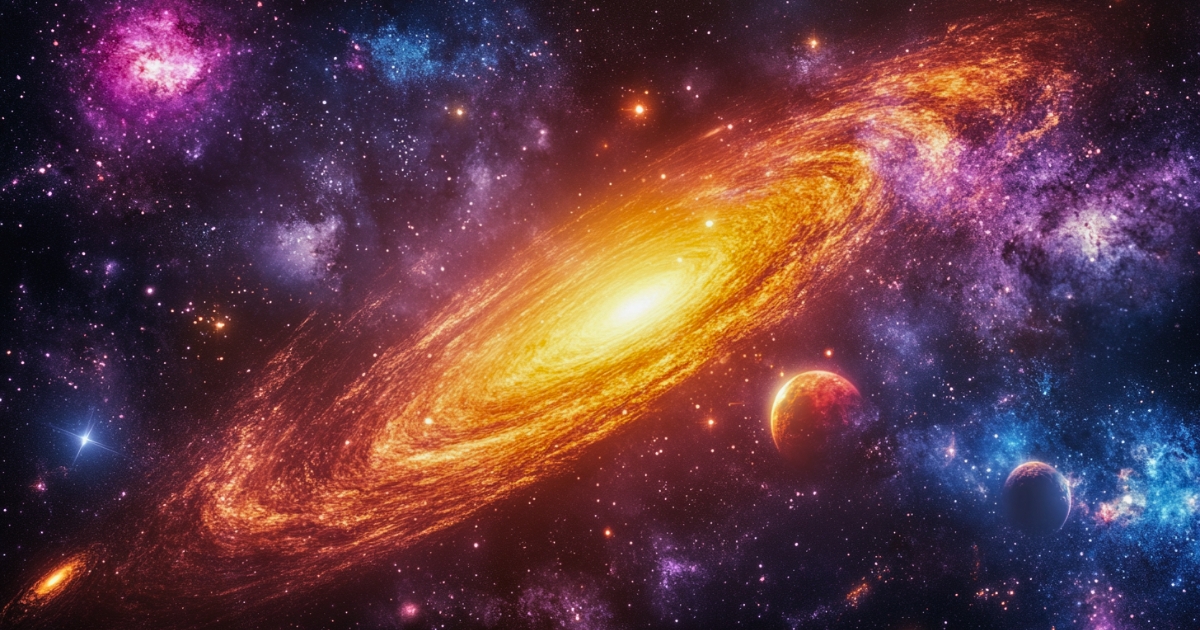What is the universe made of? This question has captivated humanity since we first gazed up at the night sky. The vast, seemingly infinite expanse of space might appear to be an “empty void” at first glance. However, modern science has revealed that the universe is composed of a diverse array of elements. In this article, we’ll explore in detail the components that make up this vast universe.
- The Beginning of Space: A Continuum Without Boundaries
- Microgravity Environment: A World in Free Fall
- Interstellar Medium: The Sparse Matter Filling Space
- Cosmic Rays: A Stream of High-Energy Particles
- Electromagnetic Waves: Messages from the Cosmos
- Magnetic Fields: An Invisible Web of Forces
- Dark Matter: The Mystery of Invisible Mass
- Dark Energy: The Mystery of Cosmic Expansion
- Spacetime Curvature Due to Gravity
- Structure of the Universe: Large-Scale Structure
- Future Research and Prospects
- Conclusion: The Mysteries of the Universe and Future Exploration
The Beginning of Space: A Continuum Without Boundaries
Let’s start with the definition of “space.” The Earth’s atmosphere gradually thins out as altitude increases. At sea level, there are about 100 billion molecules per cubic centimeter, but this number decreases dramatically as we ascend.
However, there is no clear boundary between the atmosphere and outer space. The well-known “Kármán line” (about 100 kilometers above the Earth’s surface) is merely a convenient reference point, primarily used to define the limit of aircraft flight. In reality, the definition of “outer space” varies depending on altitude. For example, NASA considers altitudes above 80 kilometers to be space flight.
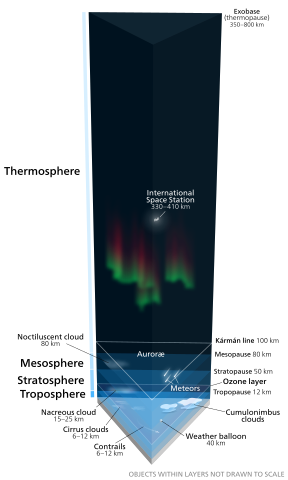
Earth’s atmospheric layers. The Kármán line is located within the thermosphere. Kelvinsong, CC BY-SA 3.0, via Wikimedia Commons
Thus, the concept of a space “boundary” is relative, and the atmosphere changes continuously with altitude. While 99% of the Earth’s atmosphere exists below 30 kilometers, a thin atmosphere continues to exist even at higher altitudes.
Microgravity Environment: A World in Free Fall
At high altitudes commonly referred to as “outer space,” the effects of gravity differ significantly from those on Earth. However, it’s often misunderstood that this environment is “zero gravity.” In fact, even in low Earth orbit (about 400 kilometers), where the International Space Station (ISS) is located, Earth’s gravity is still about 90% as strong as it is on the surface.
So why do astronauts appear to be “floating”? This is because the ISS and spacecraft are in a constant state of “free fall” as they orbit the Earth. In this state, the spacecraft and everything inside it are falling at the same speed, creating the appearance of weightlessness. This phenomenon is more accurately called a “microgravity” environment.
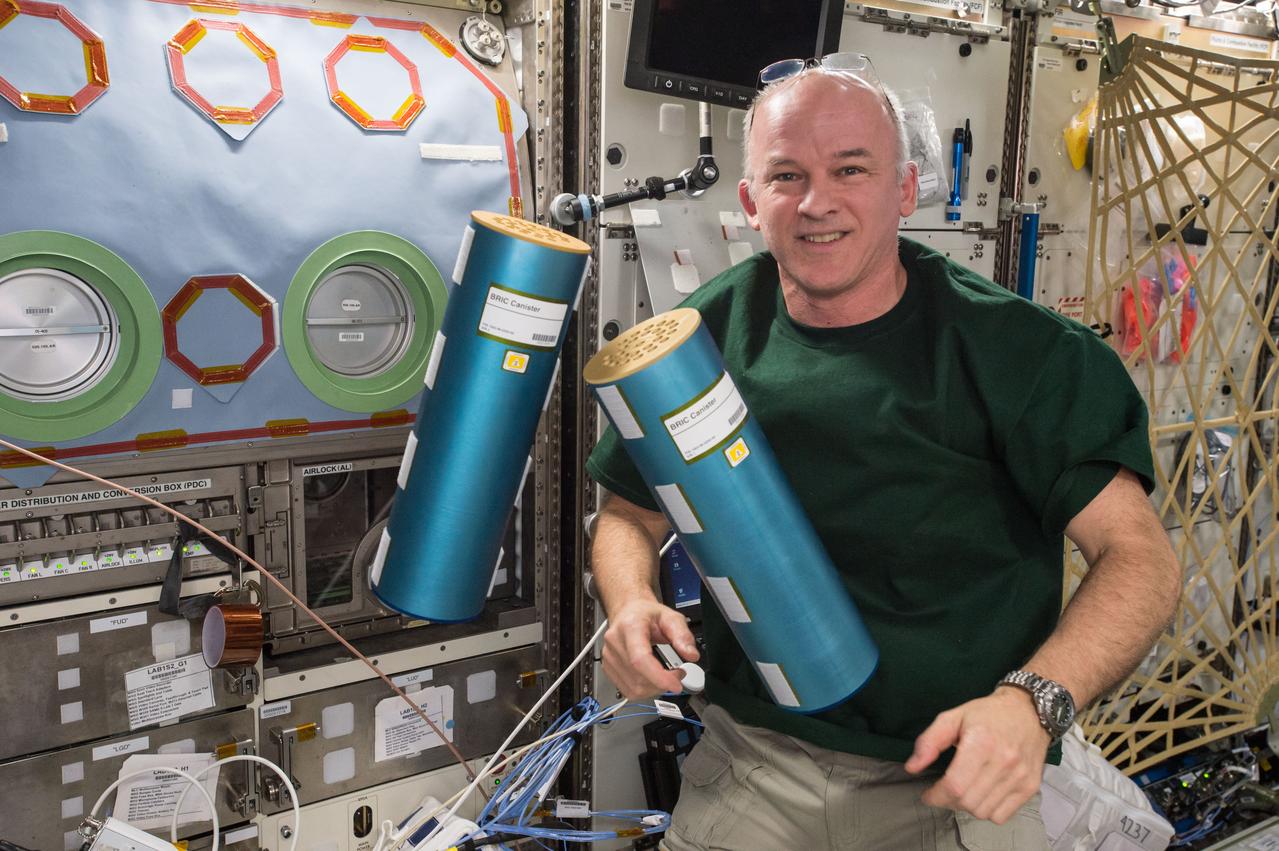
NASA astronaut Jeff Williams handling canisters for the Biological Research in Canisters – Natural Product (BRIC-NP) experiment in the Destiny laboratory of the International Space Station (ISS). This experiment screens fungal strains isolated from the Chernobyl nuclear power plant accident for the secretion of natural products that could be beneficial for biomedical and agricultural applications. By NASA
This microgravity environment has various effects on astronauts’ bodies. It changes the distribution of bodily fluids, causing space sickness and a decrease in bone density. Also, at this altitude, the curvature of the Earth becomes clearly visible, and astronauts sometimes experience the “overview effect,” a unique perspective of seeing Earth as a single planet.
Interstellar Medium: The Sparse Matter Filling Space
While space is incredibly “empty” compared to Earth’s atmosphere, it’s not completely devoid of matter. Space is filled with what we call “interstellar medium.”
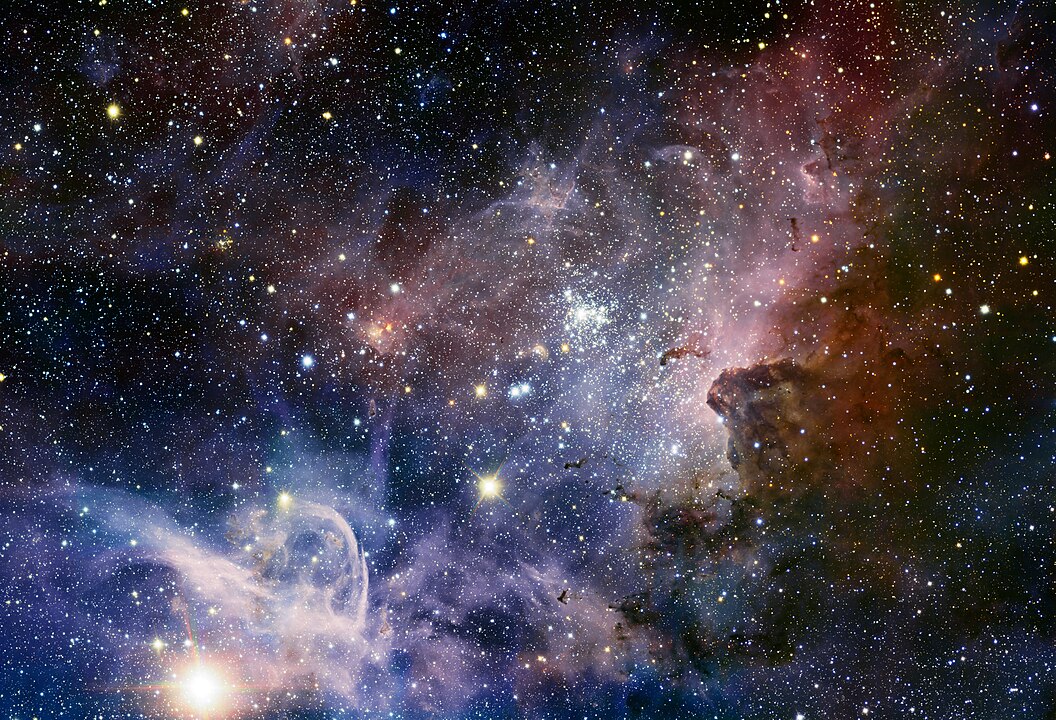
The Carina Nebula captured by the Hubble Space Telescope. The interstellar medium is visible here. By ESO/T. Preibisch – http://www.eso.org/public/images/eso1208a/, CC BY 4.0, Link
The main components of interstellar medium are hydrogen and helium. These are the most abundant elements in the universe, existing as neutral atoms or ionized particles. However, the interstellar medium also contains other elements. Trace amounts of heavier elements like oxygen, carbon, and iron, formed through processes such as supernova explosions, play crucial roles in the formation of planets and the origin of life.
Additionally, tiny particles made of elements like carbon and silicon, known as “cosmic dust,” are scattered throughout interstellar space. While these materials are extremely sparse, they amount to enormous quantities when considering the entire Milky Way galaxy. Interstellar medium serves as the raw material for new star formation and plays a vital role in the cosmic material cycle.
Cosmic Rays: A Stream of High-Energy Particles
Space is filled with high-energy particles called “cosmic rays.” The main components of cosmic rays are protons and atomic nuclei, moving at speeds close to that of light.
The origins of cosmic rays are diverse. While particles from the Sun are one type of cosmic ray, even higher-energy cosmic rays are produced by intense cosmic phenomena such as supernova explosions, matter falling into black holes, and galactic collisions.
Cosmic rays constantly bombard Earth’s atmosphere, affecting our lives in various ways. For example, airline crew members need to consider the effects of cosmic ray exposure.
Electromagnetic Waves: Messages from the Cosmos
Space is filled with various types of electromagnetic waves. Visible light is just one part of this spectrum, but there are many other types.
Particularly important is the “cosmic microwave background radiation.” This is light emitted about 380,000 years after the beginning of the universe (the Big Bang), which has been stretched to microwave wavelengths due to the expansion of the universe. It’s like the “afterglow” of the universe’s birth.
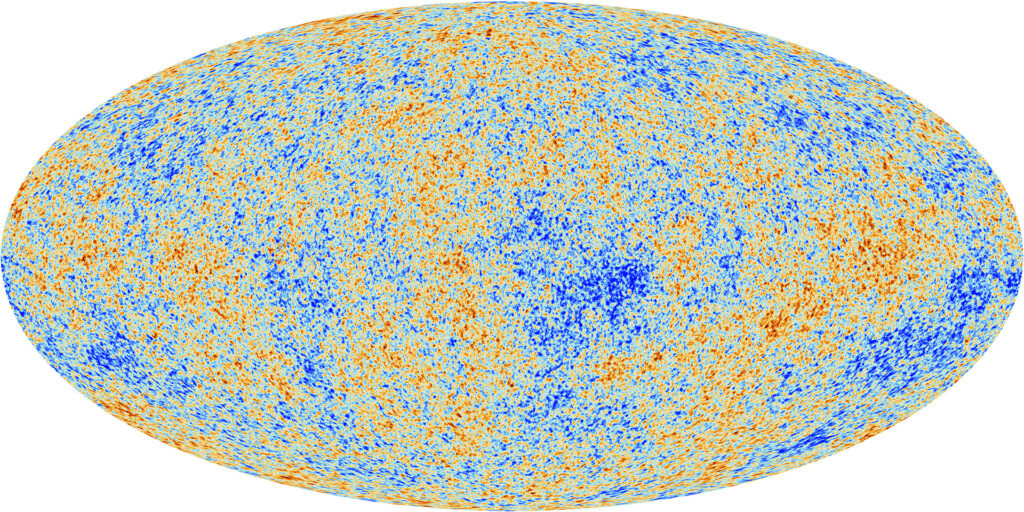
All-sky map of the cosmic microwave background radiation observed by ESA’s Planck satellite. This shows traces of the universe’s birth. By ESA and the Planck Collaboration
This radiation is observed uniformly from all directions in space, and its temperature is almost uniform except for tiny fluctuations. This uniformity provides strong evidence supporting the Big Bang theory. Moreover, by studying the minute temperature variations in this radiation, we can obtain valuable information about the age and composition of the universe.
High-energy radiation such as X-rays and gamma rays also fill the universe. These are mainly emitted by intense celestial phenomena such as supernova explosions and black holes.
The observation of electromagnetic waves is a crucial means for us to understand the universe. Some celestial phenomena invisible to the naked eye can be revealed through observations at other wavelengths of the electromagnetic spectrum.
Magnetic Fields: An Invisible Web of Forces
Space is permeated by magnetic fields generated by various celestial bodies. Stars, planets, galaxies, and many other celestial objects have magnetic fields.
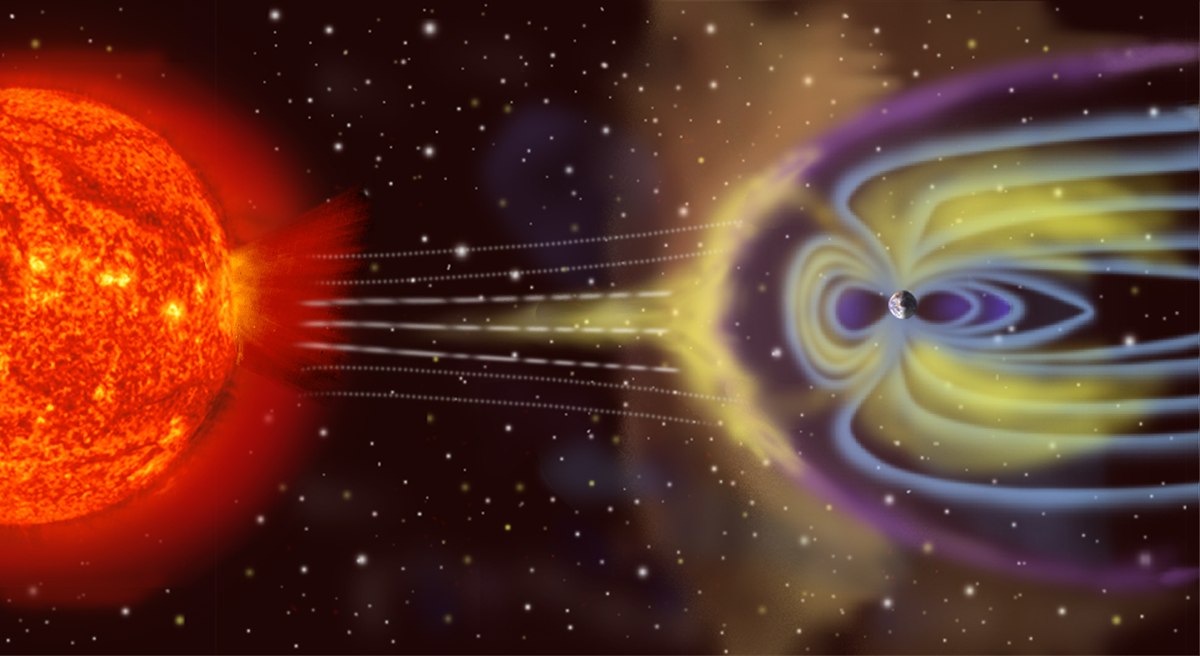
Diagram showing the interaction between Earth’s magnetic field and the solar wind. By NASA – https://www.esa.int/ESA_Multimedia/Images/2007/10/The_Sun-Earth_connection, Public Domain, Link
These magnetic fields greatly influence the movement of charged particles. For example, the stream of charged particles known as the solar wind is affected by Earth’s magnetic field, with some particles being guided towards the polar regions, creating beautiful phenomena like auroras.
Moreover, neutron stars known as “magnetars” are recognized as having the strongest magnetic fields in the universe. The strength of their magnetic fields can be trillions of times stronger than Earth’s magnetic field.
Dark Matter: The Mystery of Invisible Mass
Dark matter is thought to comprise the majority of the universe’s mass. Dark matter does not emit light and cannot be directly observed. However, its existence is indirectly inferred through gravitational effects.
For instance, when observing the rotation speeds of galaxies, we find that there is more gravity at work than can be explained by visible matter alone. Such observational results suggest the existence of invisible mass, namely dark matter.
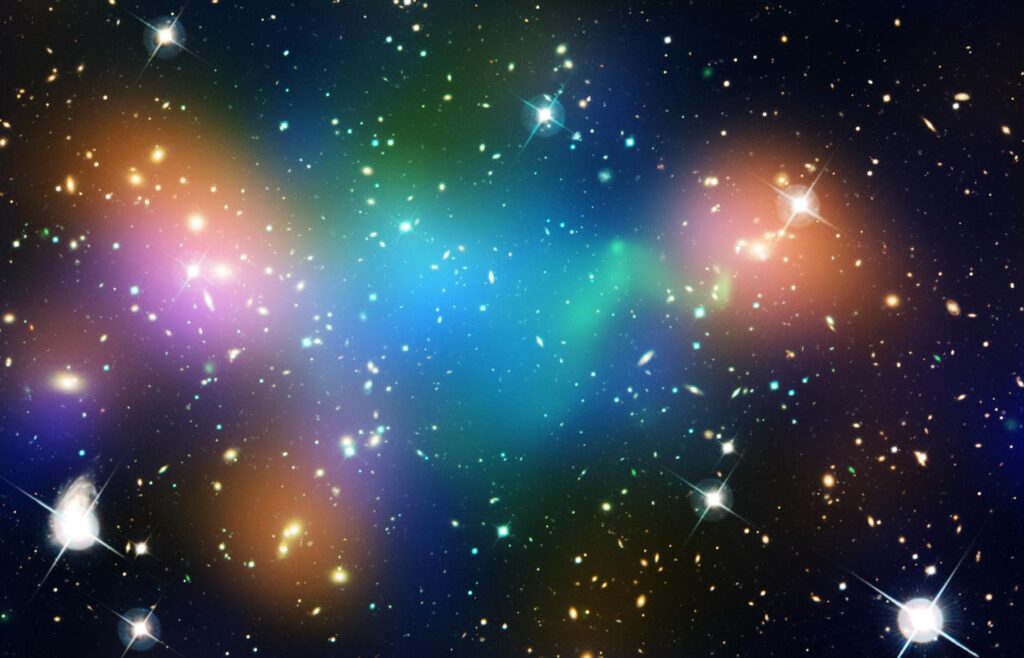
Composite image showing the distribution of dark matter, galaxies, and hot gas in the core of the merging galaxy cluster Abell 520. Orange represents starlight from galaxies, green shows hot gas, and blue indicates the distribution of dark matter. The mixture of blue and green in the center, where few galaxies are seen, indicates the presence of a dark matter clump, challenging existing theories about dark matter’s nature. By NASA, ESA, CFHT, CXO, M.J. Jee (University of California, Davis), and A. Mahdavi (San Francisco State University)
The nature of dark matter remains a mystery, and unraveling it is one of the most important challenges in modern physics. Recent research has proposed various hypotheses, including new particle candidates and modifications to gravitational theory. For example, a hypothetical particle called the “axion” is being considered as a potential candidate for dark matter.
On the other hand, there are attempts to explain observational results without assuming the existence of dark matter. Modified Newtonian Dynamics (MOND) is one such attempt, which assumes that the law of gravity changes at large distances or small accelerations. However, while MOND can explain galactic rotation curves well, it struggles to fully account for observations of galaxy cluster movements, large-scale structures of the universe, and gravitational lensing effects.
Currently, the dark matter hypothesis is widely supported as the mainstream theory because it is consistent with more observational results and provides strong evidence in observations of large-scale structures of the universe and gravitational lensing effects.
Dark Energy: The Mystery of Cosmic Expansion
Among the components of the universe, “dark energy” might be the most mysterious. Dark energy is an unknown form of energy thought to be causing the accelerating expansion of the universe.
In the late 1990s, observations of distant supernovae revealed that the expansion of the universe is accelerating. This was a surprising discovery that overturned the conventional idea that the expansion of the universe should be slowing down due to gravity.
Dark energy was proposed to explain this accelerating expansion. It is thought to have a force that pushes the universe apart, counteracting gravity, but its true nature is completely unknown.

History of the universe’s expansion. The accelerating expansion due to dark energy is shown.
According to current observational results, dark energy is estimated to account for about 70% of the energy density of the universe. In other words, the majority of the universe is filled with energy that we still don’t understand.
Spacetime Curvature Due to Gravity
According to Einstein’s general theory of relativity, gravity is understood as an effect that warps space itself. Massive celestial bodies curve the surrounding space, and this curvature influences the motion of other objects.
This effect becomes particularly pronounced near strong gravitational fields. For example, around black holes, space becomes extremely warped, preventing even light from traveling in a straight line. The “gravitational lensing effect” caused by massive celestial bodies is also explained by this spacetime curvature.
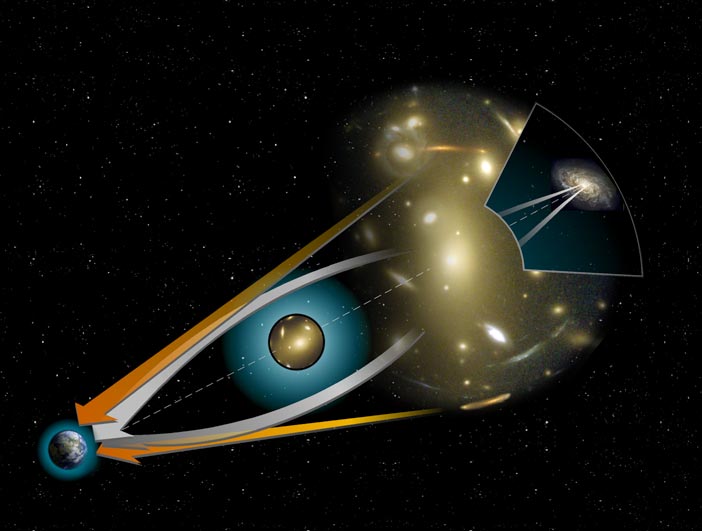
Illustration of the gravitational lensing effect. The spacetime curvature caused by massive celestial bodies bends the path of light.
Structure of the Universe: Large-Scale Structure
Finally, let’s look at the structure of the universe on a larger scale. The distribution of matter in the universe is far from uniform. Galaxies form clusters, and these clusters gather to form even larger structures.
The largest scale structures are called “filaments,” enormous thread-like structures with “voids,” vast empty regions, between them. This structure is known as the “large-scale structure of the universe” and reflects the history of cosmic evolution.
Future Research and Prospects
Scientists are advancing research in various fields to unravel the mysteries of the universe. The main areas of focus include:
- Unraveling Dark Matter and Dark Energy:
Researchers are attempting to uncover the nature of these phenomena using new detectors and observational technologies. Particularly, direct detection of dark matter particles and elucidation of dark energy’s properties through precise observations of the universe’s large-scale structure are eagerly anticipated. - Development of Gravitational Wave Astronomy:
The observation of gravitational waves has made it possible to directly detect phenomena that were previously unobservable, such as the merging of black holes and neutron stars. By observing more of these events in the future, we expect to gain new insights into the structure and evolution of the universe. - Uncovering the Early State of the Universe:
More detailed observations of the cosmic microwave background radiation are expected to deepen our understanding of the state of the universe immediately after its birth and its subsequent evolutionary processes. - Exploration of New Physical Theories:
Research is progressing on new theories such as quantum gravity and string theory, which attempt to explain the fundamental laws of the universe in a unified manner. These have the potential to fundamentally change our view of the universe.
Through these studies, we will be able to gain a deeper understanding of the components of the universe. And in the process, we should be able to gain new insights into our own place in the cosmos.
The exploration of the universe is an endless adventure that continually stimulates human intellectual curiosity. At the same time, it’s an opportunity to fundamentally question our worldview and our perception of nature. Understanding the components of the universe not only increases our physical knowledge but also provides us with an opportunity to contemplate the meaning of our own existence and humanity’s role in this vast universe.
Conclusion: The Mysteries of the Universe and Future Exploration
The universe may seem empty at first glance. However, in reality, it is filled with various elements including interstellar matter, cosmic rays, electromagnetic waves, magnetic fields, and the enigmatic dark matter and dark energy. These elements interact with each other in complex ways. The universe we live in is truly a grand “system”.
Research on the components of the universe has greatly changed our view of the cosmos. We’ve come to understand that what was once thought to be “empty space” is actually rich in content. However, at the same time, the existence of dark matter and dark energy shows that we still don’t fully understand the essence of the universe.
The journey to unravel the mysteries of the universe has only just begun. We may be opening a new chapter in the grand story of this universe. It is our individual curiosity and spirit of inquiry that will continue to weave the continuation of this story.
